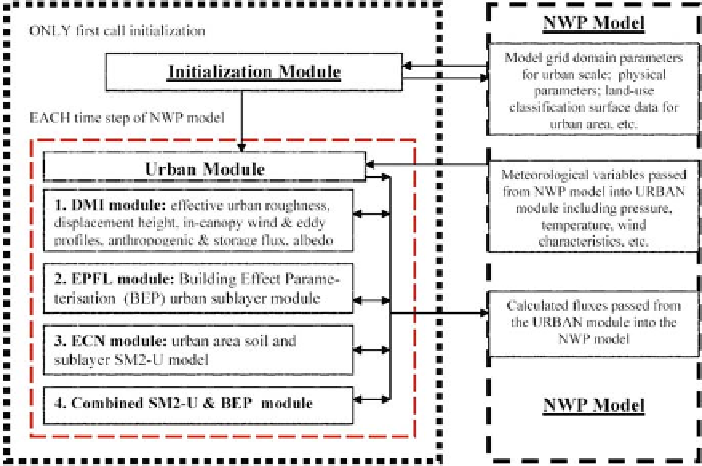Environmental Engineering Reference
In-Depth Information
Fig. 8.1
General scheme of the FUMAPEX urban module for NWP models
heat, the momentum and the turbulent fluxes inside the urban canopy, consider-
ing a simple geometry of buildings and streets (3 surface types: roof, wall and
road).
Several options for the integrated FUMAPEX urban module which can be used
with NWP models have been suggested. In the first stage, four modules for model
urbanisation (Fig. 8.1) were developed for further testing and for implementation in
NWP models or their post-processors. It included the following modules:
1. DMI module: Based on the first approach, this includes a new diagnostic analyt-
ical parameterisation of the wind profile in the urban canopy layer (Zilitinkevich
and Baklanov, 2004; Baklanov, 2008) and corrections to the surface roughness
(with the incorporation of displacement height) for urban areas, and heat fluxes
(adding anthropogenic heat fluxes, e.g., via heat/energy production/use in the
city, heat storage capacity and albedo change) within existing physical parame-
terisations of the surface layer in NWP models, but with higher resolutions and
improved land-use classification. This is applied in the city-scale version of the
DMI-HIRLAM model.
2. EPFL module of the Building Effect Parameterisation (BEP): Based on the sec-
ond approach and an improved urban surface exchange parameterisation sub-
model (Martilli et al., 2002; Hamdi, 2005). First this was tested in the research
models FVM and TVM and then considered for inclusion in the DMI-HIRLAM
and LM NWP models.

Search WWH ::

Custom Search